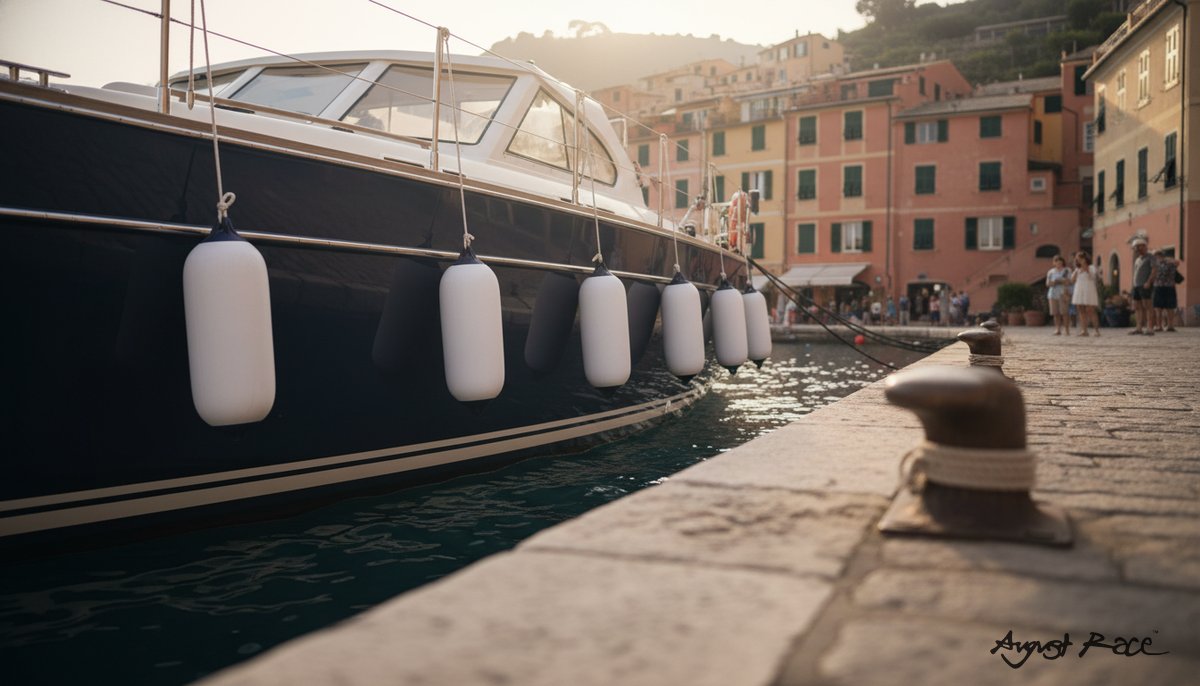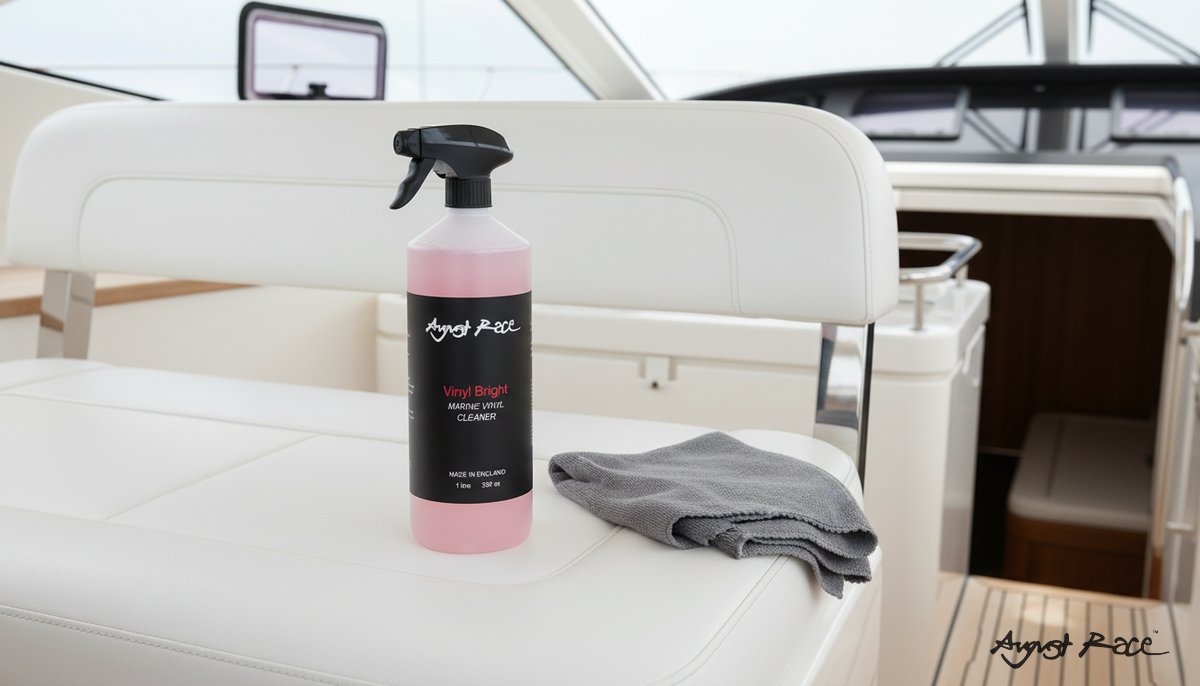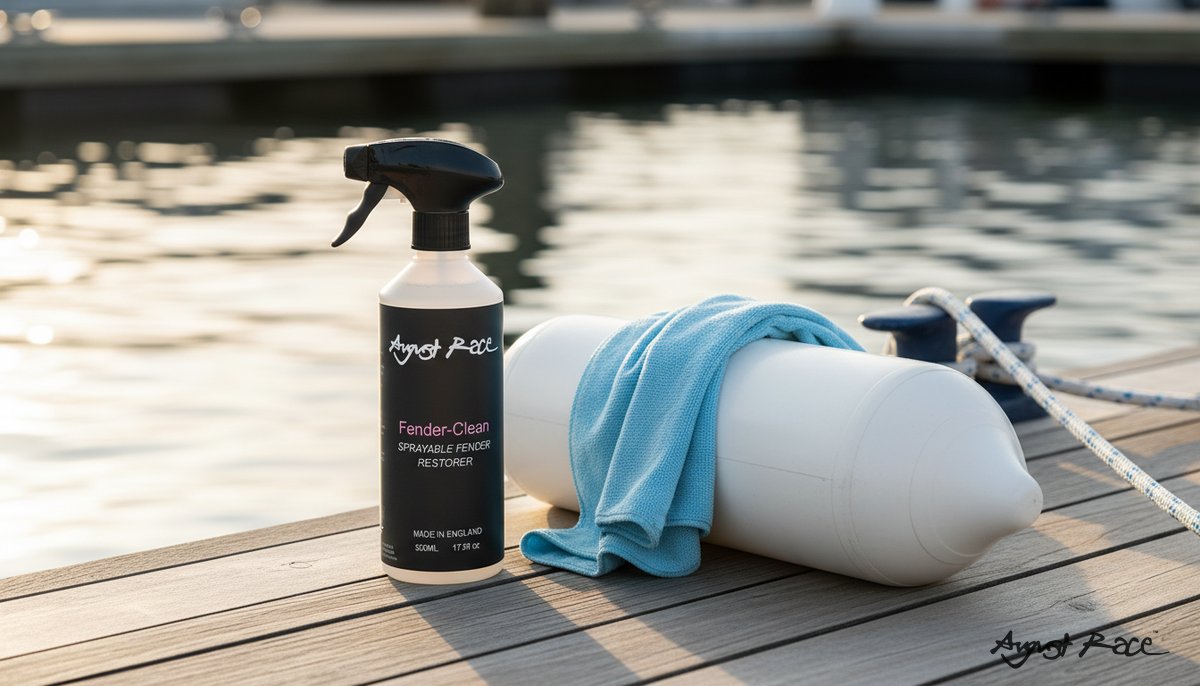How to Remove Fender Grime and Pink Stains with August Race Fender Clean
Walk any marina after a spring blow and you’ll see it: fender grime along the contact bands, slimy dockside buildup near the waterline, and those unmistakable pink streaks that don’t rinse off. As pros, we know fenders are more than bumpers -- they’re part of the boat’s first impression. Neglected fenders hint at deeper wear, UV fatigue, and lapses in care that clients notice.
You can rush it and live with a marginal clean, or you can deliver the prideful finish that wins repeat work. When pink tide shows up and algae removal is on the job sheet, I reach for August Race Fender Clean. It’s a dedicated fender solution that lets me control dwell, agitation, and finish without beating up the substrate.
From this dockside diagnosis, let’s quickly sort the contamination types so you can choose the right technique for each.
A day at the dock: why fender grime and pink tide matter to detailing pros
- Fender grime isn’t just dirt -- it’s a blend of oxidized PVC/rubber, dock scuffs, diesel mist, and salt. Left to bake, it etches and dulls gloss.
- Dockside buildup traps moisture. That moisture breeds algae and mold, which can migrate into seams and texturing.
- Pink streaks are the client’s red flag. They read “unclean” even from the pier, and they’ll drag down the look of a freshly polished hull.
If your standard wash soap is shrugging, a specialist product like August Race Fender Clean gives you controlled bite without the heavy-handed scrubbing that scars. Use it with intent and you’ll restore fenders to match a freshly buffed topsides.
Know your enemy: identifying pink stains, algae, mold and other fender contaminants
Not all “gunk” behaves the same. A quick read of color, texture, and reaction will save you time and surface.
- Pink stains fenders: Often called “pink tide,” these are bacterial pigment stains. They don’t wipe off with water. They lighten with targeted chemistry and controlled agitation.
- Algae mats: Green or brown, slightly slippery, sometimes filamentous. They shear with a brush and lift more after a short dwell. True algae removal needs repeated wetting and gentle mechanical help.
- Mold/mildew: Dark specks or patches that colonize in pores and seams. They smear when wet and may leave shadows if the substrate is UV-tired.
- Grease and dock rubber: Black/grey streaks with a waxy feel that resist light soaps but respond to focused cleaners and microfiber plus pressure.
- Embedded road grit/salt: Feels sandy. Rinse thoroughly; don’t grind it in with your first pass.
Material matters:
- PVC/vinyl fenders: Resilient but show micro-marring if you scrub too hard. Respond well to controlled chemistry and finishing polish.
- Rubber: Tough, but can haze if you get aggressive. Keep heat low if you use an orbital.
- Foam bumpers: Porous and sensitive. Avoid swelling solvents and high-pressure scrubbing. Think lower strength, more patience.
What fails (and why):
- Weak soaps: They float surface dirt but won’t touch bacterial pigments.
- Aggressive scrubbing: It removes the stain by removing the surface -- leaving scars that hold dirt later.
- Harsh solvents: Can swell foam, soften vinyl, and create patchy gloss.
Safety and substrate checks:
- Inspect for UV chalking, cracks, or seam separation. If the surface is friable, reduce dwell and agitation.
- Always patch test cleaner on an inconspicuous section before committing.
With contaminants and materials identified, here's the pro setup I use before the first application.
Pro prep: tools, PPE and staging for a flawless fender restoration
Tools I stage on the dock:
- Soft-bristled scrub brushes (short and long handle)
- Nylon detailing pad and a medium nap pad for an orbital polisher (for stubborn PVC/rubber)
- Microfiber towels (edgeless for final wipe)
- Two bottles: one for August Race Fender Clean, one for fresh water
- Buckets, hose with a fan nozzle, and a high-volume rinse if available
- Light cutting compound and a finishing polish for cosmetic restoration; DA/orbital polisher with soft backing plate
PPE and environmental care:
- Nitrile gloves and eye protection; boat shoes with grip
- Catch mats or sorbent booms beneath the work zone to prevent runoff into the marina
- Rinse station ready; keep waste water contained per marina policy
Staging like a pro:
- Secure fenders at waist height. Remove covers, lines, and hardware you can retie later.
- Work at slack or low tide when possible -- it exposes the whole fender and reduces splashback.
- Start upwind to prevent overspray drift onto topsides.
Dilution and patch test:
- Use August Race Fender Clean as directed by the label. If dilution is allowed, start conservative on foam and gradually increase as needed.
- Patch test on the underside or an end cap. Watch for softening, discoloration, or excessive chalking.
With prep dialed, here’s the step-by-step protocol that keeps control of dwell, agitation, and finish.
Step-by-step: removing pink tide stains from boat fenders with August Race Fender Clean
Step 1 -- Pre-rinse and inspect
- Use a soft fan spray to float off salt and grit. Don’t blast grit into the pores.
- Map your work: note pink zones, algae clusters, dock scuffs, and any seam wear or UV chalking.
Step 2 -- Apply August Race Fender Clean
- Apply or brush the cleaner onto targeted areas. Keep surfaces evenly wet -- no dry patches.
- Allow the recommended dwell time. You may see color softening or a slight lift as the chemistry works. Do not let it dry.
Step 3 -- Agitation technique
- Light staining: Agitate with a soft-bristled brush using short, overlapping strokes. Think of it like compounding -- keep motions cross-hatched to avoid tiger striping.
- Heavier staining: On PVC or rubber, use a DA/orbital with a medium nap pad on low speed. Minimal pressure, keep the pad flat, and move steadily. The goal is to energize the cleaner, not to cut the surface.
- Keep surfaces lubricated. If they start to squeak, you’re running too dry -- re-wet with cleaner or water.
Step 4 -- Rinse and evaluate
- Rinse with high-volume freshwater from top to bottom. Roll the fender as you rinse to flush seams.
- Evaluate under angled light. If the stain left a shadow, spot-apply and repeat with a shortened dwell.
- Know when it’s gone: True removal leaves uniform color and no halo at the edge of the stain. A lingering blush that doesn’t respond after two cycles may be embedded pigmentation -- plan for cosmetic masking instead of more aggression.
Step 5 -- Cosmetic finishing
- If the surface looks clean but dull, a light pass with a fine cutting compound on a soft foam pad can restore clarity on PVC/rubber. Keep RPMs low and monitor temperature -- heat builds fast on curved, thin materials.
- Follow with a finishing polish to refine the gloss. Wipe down with a clean microfiber, flipping often.
With the core method covered, let’s tackle the stubborn scenarios you’ll meet mid-season.
Troubleshooting and pro tips: stubborn algae, old pink stains and foam bumpers
Escalating algae removal
- Re-treat and extend dwell in small increments while keeping the surface wet. Algae lets go in layers.
- For thick mats at the waterline, use a nylon scraper or a plastic razor blade at a low angle. Work gently to avoid scoring.
- Alternate agitation tools: a short-nap scrub pad can break the biofilm without gouging.
Very old pink stains
- Long-set pinking can bond into the top layer. If repeated cycles only lighten but don’t clear the stain, stop escalating. You’re at the material’s limit.
- Cosmetic options: apply a light glaze to even the tone, or fit a fender cover in a color that matches the vessel’s scheme. If structural integrity is compromised, recommend replacement.
Foam bumpers
- Use lower chemical strength and minimal agitation. Keep rinse volumes moderate to avoid waterlogging.
- Dry thoroughly between passes. Stand them vertically to drain and allow airflow before reinstalling.
How to restore dirty fenders after summer mooring
- The fastest path for how to restore dirty fenders after summer mooring is a controlled two-cycle clean: pre-rinse, apply August Race Fender Clean, agitate lightly, rinse, then repeat shortened dwell on remaining shadows.
- Finish with a gentle polish on PVC/rubber to reset gloss. Avoid heavy cutting on aged or UV-tired material.
Pro-level finish secrets
- Temperature: Work cool surfaces. Heat accelerates drying and can haze vinyl during machine work.
- Timing: Let the surface normalize for a few minutes after cleaning before polishing; residual moisture can dilute compounds.
- Match gloss: After polishing, step back to view fenders next to topsides. If the hull is freshly buffed, increase your finishing pass to match the overall sheen.
Next, keep the win you’ve just earned through simple, seasonal discipline.
Seasonal maintenance plan: keep fenders pristine between detail visits
For coastal marinas, a little structure beats big rescues. Here are seasonal tips for fender maintenance in coastal areas that work.
Quarterly checklist
- Rinse schedule: Freshwater rinse weekly during high bloom periods; biweekly otherwise.
- Quick inspections: Look for early pinking along seams and under straps. Spot-treat before it sets.
- Algae hot spots: Pay attention to the waterline and shaded sides. Short, frequent treatments beat one big scrub.
Timing and frequency
- Spring: Deep clean after winter mooring. Address any chalking and reset gloss.
- Summer: Fast checks mid-season during peak algae. Quick spritz-and-brush with August Race Fender Clean as needed.
- Fall: After your last heavy use, clean and apply UV-protective treatments approved for the fender material.
Protective coatings
- A light, compatible conditioner can slow future dockside buildup by reducing surface grab. Test first for slip and staining.
- Avoid heavy dressings that attract dust or create a slick hazard on deck.
Records build trust
- Photograph before/after, focusing on seams, end caps, and contact bands.
- Log dates, products, dilution, dwell, and any machine work. It’s great for SOPs and for client transparency.
Before-and-after proof: case study from a summer marina restoration
A 36-foot cruiser came in after summer mooring with heavy fender grime, algae bands at the waterline, and multiple pink streaks. We staged on the pier, secured the fenders at waist height, and followed the protocol above using August Race Fender Clean.
- Process: Two treatment cycles on pink zones, extended dwell on algae, soft-brush agitation, then a light finishing polish on PVC fenders.
- Results: Approximately 90% stain reduction on the worst fender, with uniform color on the rest. Time on task averaged 35–45 minutes per fender. Your results will vary based on age and substrate.
- Visual proof: Close-ups of seam lines, end-cap edges, and the reflected dock rail showed restored clarity and consistent gloss.
The client noticed the difference from the dock. Clean fenders matched the freshly buffed hull, and we booked the boat for a mid-season maintenance plan on the spot.
Book the pro finish or try it yourself: order August Race Fender Clean
If you run a detailing crew, equip your team with August Race Fender Clean so they can handle removing pink tide stains from boat fenders without guesswork. Order in shop quantities or request a demo kit for training days from the August Race shop.
DIY-minded owners can start with a small kit and follow the step-by-step routine above. If you need an eco-friendly cleaner for moldy marine bumpers, use marina-approved products, contain runoff, and follow label guidance.
Ready to put an end to fender grime and pink streaks? Schedule a dockside demo or order a demo kit today, and pair precise technique with the right chemistry for repeatable results.
FAQs: quick answers for pros dealing with pink tide and dockside buildup
Here’s a quick-reference section you can save to your SOPs. It covers dwell times, dilution basics, and substrate checks so you can tackle pink stains fenders, algae removal, and everyday dockside buildup without overworking the surface. Work clean, contain runoff, and keep it pro.
How do I remove pink tide stains from boat fenders without damaging foam or PVC?
Patch test first. On PVC, apply August Race Fender Clean, allow the recommended dwell, then agitate with a soft brush or a DA on low with a gentle pad. On foam, go lower strength, shorter dwell, minimal agitation, and rinse thoroughly -- repeat light cycles rather than one heavy hit.
What dilution and dwell time should a pro use for algae removal with an eco-friendly fender cleaner?
Follow the label for starting dilution and keep the surface wet during dwell -- algae releases better in layers. Extend dwell in small increments if needed and use a nylon scraper or soft pad for mechanical assist, always avoiding dry scrubbing and runoff into the water.
Can August Race Fender Clean restore dirty fenders after a summer of mooring, or is replacement usually required?
Most dirty fenders respond well to the protocol here -- two cycles often clear typical summer buildup and pinking on PVC/rubber. If staining is deeply set or the material is UV-tired and brittle, you can improve appearance with careful cleaning and light polishing, but replacement may be the better long-term call.
About the Author
Sarah Rodriguez
The Detailing Professional
Owner of a high-end marine detailing business catering to luxury yachts and charter fleets. Sarah's reputation and business depend on delivering flawless results efficiently.
Expertise:
Get Expert Tips
Subscribe for marine care insights and product updates from industry professionals.
No spam. Unsubscribe anytime.
You May Also Like

August Race Fender Clean: Pro Boat Fender Cleaner
How marina teams clean fenders fast with August Race Fender Clean -- an eco-friendly fender cleaner. Workflow, KPIs, and compliance for busy berths.

August Race Fender Clean: Eliminate Fender Grime
Discover how August Race Fender Clean removes fender grime, salt and black streaks while staying non-toxic and eco-safe for busy coastal marinas.

August Race Vinyl Bright: Safe, Marine-Safe Vinyl Cleaner
Use August Race Vinyl Bright, a safe, non-abrasive, marine-safe vinyl cleaner to protect boat seats, maintain vinyl integrity, and prevent fading.
